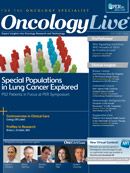A Nobel Prize in Waiting: Understanding Unexpected and Prolonged Remissions
Ipilimumab provides a striking example of the way in which some patients derive long-term benefits from therapy while others do not. The reasons for such differences should be a priority for translational research.
Maurie Markman, MD
Editor-in-Chief of OncologyLive
Senior vice president for Clinical Affairs and National Director for Medical Oncology Cancer Treatment Centers of America, Eastern Regional Medical Center
Cure is a term used in oncology to describe several possible scenarios.
First, used prospectively, it may identify a desired outcome, as in “There is a high probability that this cancer can be cured.” Or, it may indicate a clinical result that that is unrealistic, such as “We can hopefully control the symptoms of your cancer, but unfortunately cure is not a realistic goal.” Employed retrospectively, the term may acknowledge that the event appears to have occurred: “It has been more than 15 years since your surgery for cancer, and it is reasonable to declare your cancer has been cured.”
What transpires between the well-understood desire to achieve the goal of cure and the objective statement that this state has been attained is a process that, depending on the tumor type in question, may take more than a decade to confirm. And between this prospective goal and retrospective accomplishment sits the clinical state known to oncologists as remission.
The extent and duration of a clinical remission in cancer is based on a large number of factors, including those defined by biological characteristics of the cancer and host (eg, tumor type, stage, grade, molecular characteristics, patient age, sex, existing comorbidities, nutritional and immune status, normal organ function) and the treatments utilized, which would include both the specific interventions undertaken and the quality of the effort.
The complexities of this process, including the increasingly recognized molecular heterogeneity even within individual cancers, cannot be overemphasized. For example, one patient with an advanced epithelial ovarian cancer may achieve a complete response (remission) to combination chemotherapy that will not recur during the remainder of her lifetime (> 10 years), while a second woman with apparently the same type of malignancy will achieve a response that appears to be of a similar magnitude but the disease will recur within two years, and the tumor in a third such individual will progress rapidly without achieving any meaningful response to the identical antineoplastic drug regimen.
Yet, despite the rather profound limitations in our understanding of the reasons that one patient with an advanced cancer will achieve a complete response to standard therapy and another with the same tumor type, tumor grade, and stage of disease will not, it is understood that sustained remissions (leading to cure) do occur with increasing frequency in a number of settings.
Consider, for example the recent report of the long-term follow-up of a group of 177 patients with metastatic melanoma treated on three clinical trials with ipilimumab, a recently approved monoclonal antibody that blocks the immunosuppressive receptor cytotoxic T-lymphocyte-associated antigen 4 (CTLA-4) present on T cells.1 Since the median follow-up period in each of the trials exceeds five years, it is possible to examine the impact of treatment on the opportunity of patients to achieve prolonged remissions.
And, while the median overall survival for the three trials was of interest (14, 16, and 13 months), what is perhaps most striking is the percentage of patients with this extremely difficult malignancy who have survived for at least five years (13%, 25%, and 23%). Despite the duration of follow-up in this population, it remains uncertain if the extended survival indicates the malignancy has been cured but that there is certainly reason to be optimistic.
Ipilimumab provides a striking example of the way in which some patients derive long-term benefits from therapy while others do not. The reasons for such differences should be a priority for translational research. ”
Of additional interest is the fact that a number of the long-term survivors continued to maximize their measurable tumor regression long after the therapeutic program was completed, suggesting a delayed but active immunological response to the malignancy. Finally, of the 15 individuals who achieved a clinically defined complete remission, only one individual experienced ultimate progression of the disease process (with responses at the time of this report lasting as long as >8 years).
Table. Long-Term Ipilimumab Survival Data2
Treatment Group
(No patients)
Median OS
(mo)
4-year OS Rate
(%)
Ipilimumab + dacarbazine
(n = 250)
11.2
(9.4-13.6)
19.0%
(14.2-24.2)
Placebo + dacarbazine
(n = 252)
9.1
(7.8-10.5)
9.6%
(6.1-13.5)
OS indicates overall survival.
Similarly, in the longest ipilimumab survival follow-up from a phase III study, updated data indicate a median overall survival rate of 19.0% at four years (Table).2
Why have some patients experienced such pronounced biological and clinical activity of the novel therapeutic strategy, while other individuals with seemingly similar clinical features have failed to attain any measurable benefit? Discovering the answer to this provocative question in both this experience with ipilimumab in malignant melanoma and a variety of alternative immunological management approaches in this cancer and other malignancies is surely worthy of considerable effort by translational laboratory investigators working closely with members of the clinical research community.
References
- Prieto PA, Yang JC, Sherry RM, et al. CTLA-4 blockage with ipilimumab: longterm follow-up of 177 patients with metastatic melanoma [published online ahead of print January 23, 2012]. Clin Cancer Res. 2012;18(7):2039-2047. doi: 10.1158/1078-0432.CCR-11-1823.
- Maio M, Bondarenko I, Robert C, et al. Four-year survival update for metastatic melanoma (mm) patients (pts) treated with ipilimumab (IPI) + dacarbazine (DTIC) on phase 3 study CA184-024. Presented at: European Society of Medical Oncology 2012 Congress; September 28 — October 2, 2012; Vienna, Austria. Abstract 1127P.




